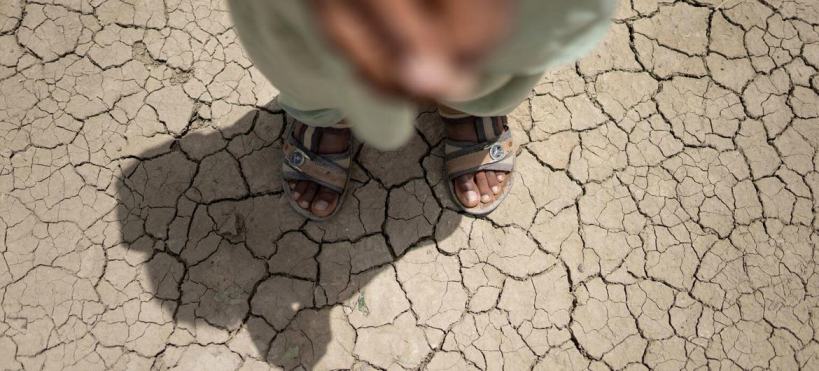Last June was the hottest month on record and the 13th month in a row to set a monthly temperature record, according to new data released by the European Union’s Copernicus Climate Change Service. For 12 months in a row, the average global temperature has been 1.5°C higher than in the pre-industrial era. The average sea surface temperature in June was 20.85°C, which is also the highest value in the entire period of observation.
“The latest Copernicus data unfortunately highlights that we will exceed the 1.5°C level every month. However, it is important to stress that temporary exceedance does not mean that the goal of limiting warming above pre-industrial levels is lost forever, as in this case we are talking about long-term warming for at least two decades,” said Celeste Saulo, Secretary-General of the World Meteorological Organization (WMO).
Under the Paris Agreement, countries agreed to keep the long-term average global surface temperature below 2°C above pre-industrial levels and to work to limit it to 1.5°C by the end of this century. The scientific community has repeatedly warned that warming of more than 1.5°C could lead to severe climate change impacts and extreme weather, and every fraction of a degree of warming matters.
Even at current levels of global warming, devastating climate impacts are already occurring. These include extreme heat waves, precipitation and droughts, shrinking ice sheets, sea ice and glaciers, accelerating sea level rise and warming oceans.

UNICEF/H. Haro Even at current levels of global warming, devastating climate impacts are already being seen
“In June, many countries experienced widespread and prolonged heatwaves that had a major impact on all aspects of people’s lives,” said Celeste Saulo. “This occurred before the traditional peak of the northern hemisphere summer, when more intense heat waves would occur.”
The Copernicus Climate Change Service carries out measurements on behalf of the European Commission with EU funding. It regularly publishes monthly climate bulletins.
“Even if the current series of extreme events eventually ends, we will see new records as the climate warms further. This is inevitable if we do not stop emitting greenhouse gases into the atmosphere and oceans,” said Carlo Buontempo, director of the Copernicus Climate Change Service.
Temperatures in June were above average in southeastern Europe and Turkey, and near or below average in western Europe, Iceland and northwestern Russia. Outside Europe, temperatures were above average in eastern Canada, the western United States and Mexico, Brazil, northern Siberia, the Middle East, North Africa and western Antarctica.
June 2024 was wetter than average over Iceland, central and much of southwestern Europe, and heavy rainfall led to flooding in Germany, Italy, France and Switzerland. It was drier than average in Ireland, much of the UK, southern Italy and much of eastern Europe, especially around the Black Sea.
Drier-than-average conditions also occurred in North America, parts of Asia, and much of South America. Severe wildfires broke out in northeastern Russia and central South America.
Arctic sea ice extent was three percent below average, close to values observed since 2010. Antarctic sea ice extent was 12 percent below average, the second lowest for June on the satellite record.
The summer of 2023 turned out to be the hottest in the last 2 thousand years. To obtain such information, scientists collected and combined a large number of paleoclimatic and historical data obtained by measuring the thickness of tree rings, as well as the results of measurements by early meteorologists and climatologists
European climatologists have accurately reconstructed the climate of Europe over the past 2,000 years using dendrochronology and other paleoclimatic approaches and concluded that the summer of 2023 was the hottest in this period of history. This was reported by the press service of the British University of Cambridge.
“Studying such a long layer of the Earth’s climate history shows how rapid the current global warming is. The past year was a record hot year, and this trend of setting new temperature records will continue unless we reduce greenhouse gas emissions as much as possible,” said Ulf Büntgen, a professor at the University of Cambridge, whose words are quoted by the university’s press service.
The researchers made the discovery as part of a project to reconstruct Europe’s summer climate over the past 2,000 years. To obtain this information, the scientists collected and combined a large amount of paleoclimatic and historical data, obtained by measuring the thickness of tree rings, as well as the results of measurements by early meteorologists and climatologists in the 19th and 20th centuries.

In total, the researchers combined 15 similar data sets, which allowed them to reconstruct summer temperature variations from the end of the ancient era to the present day with the highest possible accuracy. This allowed climatologists to refine average warm-season temperatures in the pre-industrial era, as well as to determine the hottest and coldest summers in European history.
Thus, scientists’ calculations indicate that summer temperatures were unusually high in Europe at the end of the ancient era, in 246 and 282 AD, as well as in the middle of the Middle Ages, in 986 and 1061. In these years, summer temperatures were 0.7-0.88 degrees Celsius higher than typical values for the pre-industrial era. But the coldest summer seasons occurred at the beginning of the Middle Ages (536 and 627) and in the early modern period (1601, 1642), when temperatures were 1.2-1.86 degrees Celsius lower than normal.
At the same time, the researchers note that the positive temperature records they identified are significantly lower than 2023, when summer temperatures were 2.07 degrees Celsius above the pre-industrial average. This means that the summer of 2023 was, on average, almost 4 degrees warmer than in 536, during the coldest summer in the last 2,000 years. This once again demonstrates the extremely high rate of climate change and emphasizes the need to reduce emissions, the scientists concluded.
2023 has become the hottest year in the history of observations conducted by scientists over the past two centuries. According to experts from the World Meteorological Organization and the US National Oceanic and Atmospheric Administration, average temperatures in 2023 exceeded the historical norm by about 1.2-1.4 degrees Celsius, which is more than enough to beat the previous record set in 2016.
The 2015 Paris Agreement, designed to limit global warming to 1.5 degrees Celsius above pre-industrial levels, has already been breached, according to European scientists who found that last summer was the hottest on Earth in 2,000 years across the entire Northern Hemisphere, the journal Nature reports.
In particular, new estimates based on tree rings suggest that the summer of 2023 was 2.07 degrees Celsius warmer than pre-industrial levels — meaning the world has warmed beyond previous estimates, which put the figure at 1.48 degrees Celsius above pre-industrial levels. Relatively sparse data from the Southern Hemisphere, which responds differently to climate change than its northern counterpart, make it difficult to draw conclusions about the region’s climate over the past 2,000 years, the scientists say, so their study focuses on the Northern Hemisphere.
However, the new discovery does not come as a surprise to climate scientists after we saw record temperatures sweltering across the U.S., Europe, China and other regions around the world throughout last summer. It was hot enough to melt Antarctic sea ice to record lows and fuel Canada’s worst wildfire season, which scorched an unprecedented 45 million hectares of land.
“I’m not surprised,” Jan Esper, a climate scientist at Johannes Gutenberg University in Germany, told reporters at a news conference. “I’m concerned about global warming — it’s one of the biggest threats.”
In addition to global warming caused by greenhouse gas emissions, primarily from human activities like burning coal, the unprecedented heat of 2023 has been exacerbated by El Niño, a recurring weather pattern that unfolds in the Pacific Ocean and is associated with higher temperatures on average. Scientists say global warming caused by heat-trapping gases is actually making El Niño stronger over the past 60 years, which affects weather around the world, increasing already high temperatures and leading to hotter, longer summers with severe heat waves like those seen last year.

Although the weather patterns are now easing towards neutral conditions, scientists warn that this summer is likely to break records again. April has already been recorded as the hottest on record after extreme ocean temperatures persisted for a 13th consecutive month, according to the European Union’s Copernicus Climate Change Service.
“It’s clear that we need to do as much as possible as quickly as possible,” Esper said.
Esper and his team analyzed archival data on annual temperature variations recorded in tree-ring widths, which the scientists say is the only reliable record spanning the past 2,000 years. By comparing the tree-ring records with early instrumental records, the period from 1850 to 1900, cited in the 2015 Paris Protocol to describe preindustrial temperatures, “was a few tenths of a degree Celsius cooler than previously thought,” the scientists say. By recalibrating that baseline, which they say was first calculated using patchy and sometimes inconsistent instrumental data from the 19th century, they found that the planet has warmed by 2.07 degrees Celsius above preindustrial levels, higher than previous estimates suggested.
The results are also consistent with a recent report from the World Meteorological Organization (WMO) confirming that 2023 will be the warmest year on record, and possibly the warmest in 100,000 years. “The state of the climate in 2023 has given the phrase ‘off the charts’ a new ominous meaning,” the WMO said in a statement.
Scientists say the temperature difference between historical tree-ring data and instrumental data “fundamentally challenges the calculation of the temperature ranges considered in the 2015 Paris Agreement.” The new findings mean that the goal sought by nearly 200 countries under the agreement to keep global warming to 1.5 degrees Celsius above pre-industrial levels “has already been surpassed,” according to a new study .
“On one level, it’s just a technical issue — warming hasn’t changed, reality hasn’t changed,” Esper told reporters. But, he added, “it’s important to get the numbers right.”
Additional tree-ring measurements from other parts of the world will allow scientists to contextualize their findings further back in time. “There’s a lot of wood out there,” Esper told reporters during a briefing. But scientists have encountered difficulties and delays in getting permission to sample trees, he noted. “Often we don’t get permission or it takes too long, and that of course hinders progress in creating longer records and updating records.”
In early July, the Blue Book on Climate Change in China to 2024 was published, providing the latest information on monitoring the status of climate change in China and the world from the perspectives of the atmosphere, hydrosphere, cryosphere, biosphere and factors influencing climate change.
The Blue Book notes that the global warming trend continues. An analysis of global land surface temperature data collected by the China Meteorological Administration (CMA) found that the average global temperature in 2023 was the warmest since records began in 1850, and that the average global temperature over the past 10 years (2014–2023) was about 1.2°C warmer than the pre-industrial period. The regional average temperature in Asia in 2023 was 0.92°C warmer than normal, the second warmest since 1901, and the annual average land surface temperature in China in 2023 was 0.84°C warmer than normal, the warmest year since 1901.
Extreme weather and climate events are becoming more frequent and intense, including in China. At the same time, the occurrence of extremely low temperatures has also been noted to be more frequent. The average number of days with dust storms and gales in the northern region of the Celestial Empire has shown a significant downward trend, reaching a minimum in recent years, and the average intensity of typhoons hitting land in China has increased significantly since the late 1990s.

The warming of the world’s oceans has accelerated significantly, with sea surface temperatures and ocean heat content reaching new highs, and the global average sea level continuing to rise. Sea levels in coastal China are generally on an accelerated rise trend, and in 2023 they will be 72 cm higher than the average for the period 1993-2011.
The global glacier retreat accelerated, and mountain glaciers in western China also showed an increasing melting trend. The degradation of permafrost along the Qinghai-Xizang Highway is obvious.
China’s overall green cover has been steadily increasing, showing a continuous greening trend. From 2000 to 2023, China’s annual average normalized vegetation index (NDVI) showed a significant upward trend, and in 2023, it reached the third highest value since 2000.
The Blue Book also shows that global concentrations of the main greenhouse gases are increasing every year. Global average atmospheric concentrations of carbon dioxide (CO₂), methane (CH₄) and nitrous oxide (N₂O) have reached their highest levels since records began.




